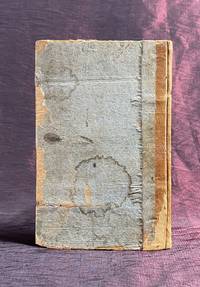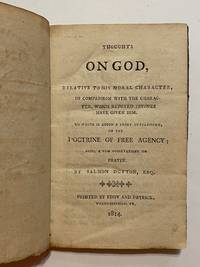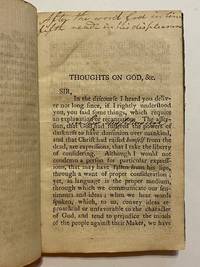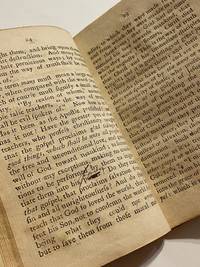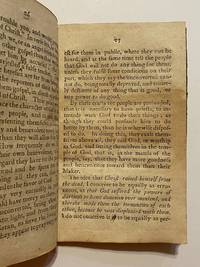[AMERICAN SCALEBOARD ("SCABBARD") BINDING]. Thoughts on God, Relative to His Moral Character, in Comparison with the Character, which Reputed Divines have Given Him
- SIGNED
- Weathersfield, Vermont: Eddy and Patrick, 1814
Weathersfield, Vermont: Eddy and Patrick, 1814. First Edition. Good. 12mo. 102 pp. (typical foxing, lacking final endleaf). Contemporary scaleboard binding: quarter sheep over scaleboard covered with drab blue paper (binding extremities and corners worn, lower fore-corner bumped and partially defective, back cover stained, with portions of the paper covering and leather worn away, 2" horizontal split in scaleboard). With substantive corrections in the hand of the printer or author on pp. [7], 24 and 27. EARLY AMERICAN SCALEBOARD BINDING ON AN UNCOMMON PROVINCIAL IMPRINT; OUR COPY BEARS CORRECTIONS IN THE HAND OF THE PRINTER OR AUTHOR ON THREE PAGES. THIS UNIVERSALIST TEXT IS QUITE UNKNOWN AND TO OUR KNOWLEDGE HAS NO DIGITAL SURROGATE AND HAS NEVER BEEN REPRINTED.
THE BINDING: Scaleboard (a.k.a. scabbard or scabboard) was made from very thin sheets of wood that had been split (going towards the grain) instead of being sawed. Whereas the survival rate of early American scaleboard bindings is not high, owing to their fragile nature, they were once in great abundance, used in place of paste or pulpboard from the 1680s until the mid-nineteenth century, most often on widely disseminated texts such as this one. In the present binding, the grain of the scaleboard is horizontal, a common New England practice.
THE AUTHOR: Dutton (1743-1824), a veteran of the American Revolutionary War, was an entrepreneur, road surveyor, justice of the peace, and the founder and treasurer of the town of Cavendish. Dutton was a universalist, but he was no preacher (and was thus exempted from a "preacher tax"). His commitment to education is notably evidenced by his $7500 contribution towards the building of Cavendish Academy. The original Dutton House, built in 1782, still stands and now forms part of the Shelburne Museum.
THE PRINTERS: In 1813 the Weathersfield engraver Isaac Eddy purchased from Alden Spooner, of Windsor, an "old press" (erroneously called the Stephen Daye Press), and went into the printing business. Over the next three years he, either alone or in association with his sometime partner, Samuel Patrick, Jr., issued fourteen imprints from the
Weathersfield office. (SOURCE: Harold G. Rugg, "Isaac Eddy, Printer-Engraver," Bibliographical Essays, a
Tribute to Wilberforce Eames, 1924, pp. 313-329).
PROBABLE PROVENANCE: Gertrude Mallary (her sale at University of Vermont conducted by William Parkinson Books, 11/6/2004, lot 135 - likewise lacked the back flyleaf).
Scarce in commerce: ours is the ONLY one currently on the market. The Mallary copy (i.e. the present copy?), and the one in the 1915 G.E. Littlefield sale (C.F. Libbie, Nov. 16, lot 2856) are the ONLY ones listed in Rare Book Hub, which currently lists more than 15 million records in the Rare Book Transaction database.
McCorison 1599. Gilman, Bibliography of Vermont, p. 78. Eddy, Universalism in America, p. 497 (no. 200). Shaw and Shoemaker 31378.
THE BINDING: Scaleboard (a.k.a. scabbard or scabboard) was made from very thin sheets of wood that had been split (going towards the grain) instead of being sawed. Whereas the survival rate of early American scaleboard bindings is not high, owing to their fragile nature, they were once in great abundance, used in place of paste or pulpboard from the 1680s until the mid-nineteenth century, most often on widely disseminated texts such as this one. In the present binding, the grain of the scaleboard is horizontal, a common New England practice.
THE AUTHOR: Dutton (1743-1824), a veteran of the American Revolutionary War, was an entrepreneur, road surveyor, justice of the peace, and the founder and treasurer of the town of Cavendish. Dutton was a universalist, but he was no preacher (and was thus exempted from a "preacher tax"). His commitment to education is notably evidenced by his $7500 contribution towards the building of Cavendish Academy. The original Dutton House, built in 1782, still stands and now forms part of the Shelburne Museum.
THE PRINTERS: In 1813 the Weathersfield engraver Isaac Eddy purchased from Alden Spooner, of Windsor, an "old press" (erroneously called the Stephen Daye Press), and went into the printing business. Over the next three years he, either alone or in association with his sometime partner, Samuel Patrick, Jr., issued fourteen imprints from the
Weathersfield office. (SOURCE: Harold G. Rugg, "Isaac Eddy, Printer-Engraver," Bibliographical Essays, a
Tribute to Wilberforce Eames, 1924, pp. 313-329).
PROBABLE PROVENANCE: Gertrude Mallary (her sale at University of Vermont conducted by William Parkinson Books, 11/6/2004, lot 135 - likewise lacked the back flyleaf).
Scarce in commerce: ours is the ONLY one currently on the market. The Mallary copy (i.e. the present copy?), and the one in the 1915 G.E. Littlefield sale (C.F. Libbie, Nov. 16, lot 2856) are the ONLY ones listed in Rare Book Hub, which currently lists more than 15 million records in the Rare Book Transaction database.
McCorison 1599. Gilman, Bibliography of Vermont, p. 78. Eddy, Universalism in America, p. 497 (no. 200). Shaw and Shoemaker 31378.


![[AMERICAN SCALEBOARD ("SCABBARD") BINDING]. Though](https://d3525k1ryd2155.cloudfront.net/h/004/403/1701403004.0.x.jpg)
